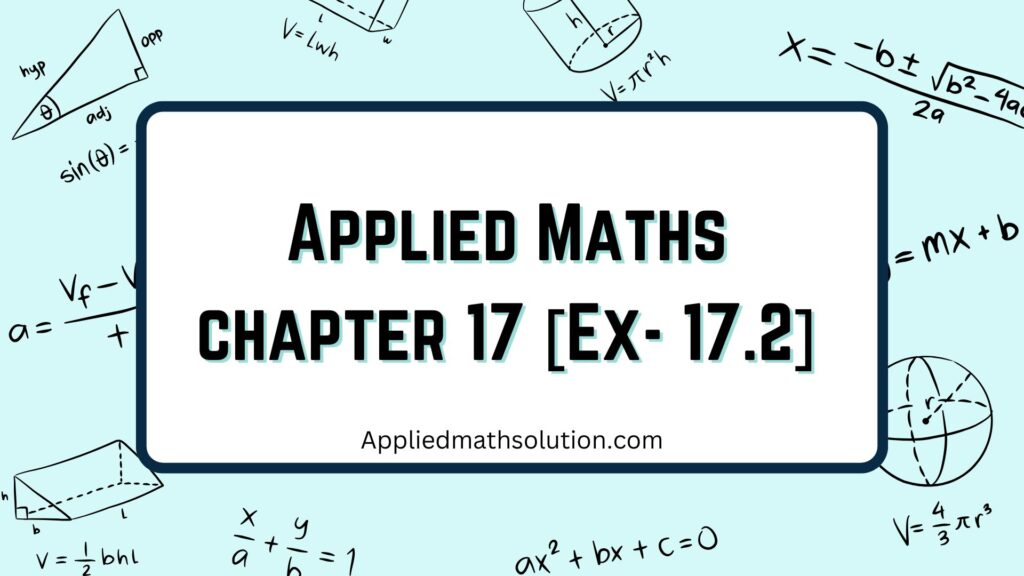Welcome to Class 11 Applied Maths Chapter 17, where we embark on an exciting journey into the world of advanced mathematical concepts tailored for Class 11 students.” Unlock the power of applied mathematics with expert solutions crafted by professionals at AppliedMath.com. Designed to propel students towards academic success, our meticulously curated ML Aggarwal Solutions for Applied Mathematics cater to Class 11 and class 12 students seeking mastery in their examinations. Every query from the CBSE ML Aggarwal Books finds a comprehensive answer on our platform, complete with detailed explanations and step-by-step solutions presented in an easily understandable language.
Dive into the world of applied mathematics and discover how our resources can elevate your understanding and performance. Keep reading to explore the wealth of ML Aggarwal Solutions for Class 11 and Class 12 Applied Mathematics.
Here we provide you with Class 11 Applied Maths Chapter 17, to help you gain a comprehensive understanding of the chapter and its concepts. https://appliedmathsolution.com/wp-admin/post.php?post=6&action=edit

Class 11 Applied Maths Chapter 17 Solutions
Straight Line
EXERCISE- 17.2
Q.1 Find the slope of the line passing through the points:
(i) (2,-3) and (-5,9)
(ii) (0,-4) and (-6, 2)
(iii) (3,-5) and (-4,-5)
(iv) (-3, 5) and (-3,-4)
Ans. (i)
Using, m = (y2 – y1)/(x2 – x1), we get,
m = (9 – (-3))/(-5 – 2)
= (9 + 3)/-7
= – 12/7
(ii) Using, m = (y2 – y1)/(x2 – x1), we get,
m = (2 – (-4))/(-6 – 0)
= (2 + 4)/-6
= – 6/6 = -1
(iii) Using, m = (y2 – y1)/(x2 – x1), we get,
m = (-5 – (-5))/(-4 – 3)
= (-5 + 5)/-7
= 0 [y – coordinates are equal, hence, line would be parallel to x- axis.]
(iv) Using, m = (y2 – y1)/(x2 – x1), we get,
m = (-4 -5))/(-3 – (-3))
= -9/(-3 + 3)
= – 9/0 = ND [ x- coordinates are equal, hence, line would be parallel to x- axis]
Q.2 What is the slope of a line which is parallel to
(i) x-axis
(ii) y-axis?
Ans. (i) Line which is parallel to x- axis, the slope will be 0.
(ii) Line which is parallel to y- axis, the slope will be ND (Not Defined).
Q.3 Find the slope of a line whose inclination is:
(i) 30°
(ii) 120°
(iii) 135°
(iv) 90°
Ans. (i) Using, m = tanθ, we get,
m = tan 30° = 1/√3
(ii) Using, m = tanθ, we get,
m = tan 120° = -√3
(iii) Using, m = tanθ, we get,
m = tan 135° = -1
(iv) Using, m = tanθ, we get,
m = tan 90° = ND (Not Defined)
Q.4 Find the inclination of a line whose slope is:
(i) 1/√3
(ii) 1
(iii) -1
(iv) √3
(v) -√3
(vi) 0
Ans.
(i) Using, m = tanθ, we get,
1/√3 = tanθ
tan 30° = tanθ
Therefore, θ = 30°
(ii) Using, m = tanθ, we get,
1 = tanθ
tan 45° = tanθ
Therefore, θ = 45°
(iii) Using, m = tanθ, we get,
-1 = tanθ
tan 135° = tanθ
Therefore, θ = 135°
(iv) Using, m = tanθ, we get,
√3 = tanθ
tan 60° = tanθ
Therefore, θ = 60°
(v) Using, m = tanθ, we get,
-√3 = tanθ
tan 120° = tanθ
Therefore, θ = 120°
(vi) Using, m = tanθ, we get,
0 = tanθ
tan 0° = tanθ
Therefore, θ = 0°
Q.5 A line passes through the points (4, -6) and (-2, -5). Does it make an acute angle with the positive direction of x-axis?
Ans. Given : A line passing the points (4, -6) & (-2, -5).
Using, m = (y2 – y1)/(x2 – x1), we get,
m = (-5 – (-6))/(-2 – 4)
= (-5 + 6)/-6
= -1/6
m = -1/6
Therefore, m < 0
Also, m = tanθ
Tan θ < 0
We know that, For all θ ∈ [0, 90]
tan θ > 0
But here, tan θ < 0, hence 90 < θ < 180.
Therefore, No, θ would not make an acute angle with the positive direction of x- axis.
Q.6 Determine x so that 2 is the slope of the line through the points (2,5) and (x, 3).
Ans. Given, slope of line passing through (2, 5) & (x, 3) is 2.
Using, m = (y2 – y1)/(x2 – x1), we get,
2 = (5 – 3)/(2 – x)
2 = 2/(2 – x)
1 = 1/(2 – x)
2 – x = 1
2 – 1 = x
x = 1
Q.7 What is slope of line passing through origin and the mid-point of the line segment joining the point (2,-5), (3, 2)?
Ans. Given : A line segment joining points (2, -5) & (3, 2)
Using, x = (x1 + x2)/2, y = (y1 + y2)/2 [Mid point formula]
we get, x = (2 + 3)/2, y = (-5 + 2)/2
x = 5/2 ; y = -3/2
Therefore, mid point of line segment (5/2, -3/2)
Now, slope of line passing through origin (0, 0) & mid point of line segment (5/2, -3/2) would be
m = (-3/2 – 0)/(5/2 – 0) [Two point formula]
m = (-3/2)/(5/2)
m = (-3/2) x (2/5)
m = -3/5
Therefore, slope of the line is -3/5.
FAQ’s related to Class 11 Applied Maths Chapter 17 on Straight Line:
Q.1 What is the general equation of a straight line?
Ans. The general equation of a straight line is given by: Ax + By + C = 0 where A, B, and C are constants, and x and y are variables representing the coordinates of any point on the line.
Q.2 What is the slope-intercept form of a straight line?
Ans. The slope-intercept form of a straight line is: y = mx + c where m is the slope of the line, and c is the y-intercept (the point where the line crosses the y-axis).
Q.3 How do you find the slope of a line given two points?
Ans. The slope mmm of a line passing through two points (x1, y1) and (x2, y2) is calculated using the formula: m = (y2 – y1)/(x2 – x1)
Q.4 What is the equation of a horizontal line?
Ans. The equation of a horizontal line is : y = k where k is a constant representing the y-coordinate of all points on the line.
Q.5 What is the equation of a vertical line?
Ans. The equation of a vertical line is: x = k where k is a constant representing the x-coordinate of all points on the line.
These are a few Frequently Asked Questions relating to Class 11 Applied Maths Chapter 17
In Class 11 Applied Maths chapter 17, you will explore fascinating topics that form the backbone of practical problem-solving techniques. Through clear explanations, illustrative examples, and step-by-step solutions, you’ll grasp complex concepts effortlessly. Whether you’re preparing for exams or simply eager to deepen your mathematical understanding, Class 11 Applied Maths Chapter 17 promises an enriching learning experience that will set you on the path to success. Class 11 Applied Maths Chapter 17, we delve deep into advanced mathematical concepts that are crucial for understanding.

